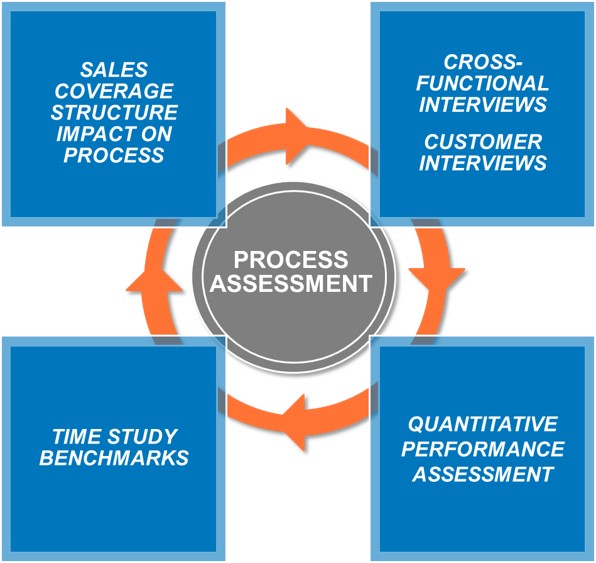How to Identify and Fix Five Common Sales Process Mistakes
The manufacturing sales model is rapidly evolving. Unfortunately, poorly developed and inadequately applied sales processes in the manufacturing space abound. To adapt, sales team leaders must clearly articulate and execute an enhanced sales process.
Identify Common Sales Process Mistakes
Well-defined sales processes provide a great blueprint – and opportunity – to coordinate innovative sales models. Identifying five common sales process mistakes and how to fix them will accelerate the needed change.
Mistake 1: Confusion About What The Sales Process Is
AGI’s clients in manufacturing have diverse and narrow definitions of “sales process.” Common flawed definitions include ‘sales training,’ ‘CRM,’ or ‘the 20+ step procedure manual to input a new order.’ These clients seldom mention Target customer segments, buyers / influencers, value propositions or high-value sales time. All of the above can explain aspects of a sales process. However, at its core, sales process should be defined in the following way:
Sales Process is a high-level blueprint (usually no more than 10-15 pages in total) highlighting key needs, actions, sales roles and tools to effectively execute the desired Revenue Motions involving the Sales function.
Figure 1 below illustrates the breakdown of the sales process across the three main steps of Revenue Motions.
Figure 1
Mistake 2: Launching a Sales Process in Isolation of Other Sales Programs
Even if companies have a rough understanding of what sales process entails and have done a reasonable job of articulating the preferred process, these initiatives often fail because they are not well integrated into a broader change effort. Often a project management team develops the process and simply hands it over to the sales team. Solution: Effectively launching a new sales process requires close integration of other change initiatives, which can include:
- New sales training curriculum
- New / upgraded sales roles and competencies
- New sales incentive plan
- Upgraded CRM program – aligned closely with new process
- Coaching program for front-line managers
- Marketing collateral and programs to support new process
Mistake 3: ‘Operationalizing’ the Sales Team
Perhaps the greatest sin manufacturers commit is treating sales process like any other ‘operational efficiency initiative.’ This leads to often laughable, 100+ step sales process documents that prescribe every possible action a seller must execute to interact with a customer and complete the order. These voluminous documents contain incomprehensible jargon and dozens of tedious activities that sellers complete to close even the simplest of transactions. Solution: burn the ’Six-Sigma Sales Procedures Manual’ and start from scratch.
Mistake 4: Not Integrating Sales Process with Broader ‘Revenue Motions’
Often a sales process starts and stops with the sales team, excluding other key players like Marketing, Customer Service and Delivery. This can be particularly problematic because many manufacturers do not realize the dynamic demand stimulation Marketing provides or how heavily involved sellers are in the post-sales fulfillment process. AGI has worked with several clients who were shocked to realize after a gap analysis that 60+ percent of sellers’ time was focused on fulfilment and not selling activities. Other clients want to launch key new products and services and don’t realize they need closer integration with Marketing to be successful.
Mistake 5: Not Conducting a Proper Gap Assessment
Finally, many companies do not have a good approach or even the resources to conduct a proper gap analysis of both the current- and future-state sales processes. A comprehensive assessment requires balancing quantitative and qualitative analysis methods. Gap assessments should include a broad spectrum of functional leader input (e.g., Marketing, Customer Service) as well as external data focused on customer needs and market trends. (Figure 2)
Figure 2

How to Improve the Sales Process
Fortunately, there are proven approaches to fix a dysfunctional sales process.
Sellers should:
- Gain a good understanding of what sales process is and how it fits into their other revenue motions (marketing, fulfillment, customer service).
- Understand the broader sales issues. Is sales process a top concern, or are there more pressing issues to tackle upstream in one’s account segmentation, sales channels or organizational structure?
- Conduct an appropriate and comprehensive assessment of the process gaps.
- Create an actionable, high-level, sales process document to guide the new process implementation. Ensure that appropriate stage gate criteria and step-by-step phases and activities are clear.
- Execute key support programs guided by the sales process blueprint. These programs can include new sales roles, new training curriculum, coaching guides, upgraded CRM, re-designed compensation plans and segment-specific marketing collateral.
Improve Your Sales Process With Alexander Group
Visit AGI’s Manufacturing practice, or reach out to one of our Manufacturing vertical experts. We would be glad to discuss this topic in more detail.